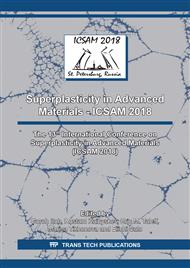p.391
p.397
p.403
p.407
p.413
p.419
p.424
p.430
p.437
Mechanical Behavior of Ti-6Al-2Sn-4Zr-2Mo Titanium Alloy under Hot and Superplastic Forming Conditions: Experiment and Modeling
Abstract:
Titanium alloys are widely used in the aircraft industry. Under sheets form, they can be employed to the manufacturing of pylon or engine parts. With the aim of a cost reduction, this study proposes to act on the starting microstructure so as to improve the mechanical properties during the forming stages. In the present study, investigations are focused on Ti-6Al-2Sn-4Zr-2Mo (Ti6242) alloy specially used for the hot areas (e.g. parts close to the engine or the combustion chambe...). Presently, an important mechanical test campaign was performed on Ti6242 alloy, it examines, on the one hand, the microstructure qualified by the aircraft industry and, on the other hand, a new range of refined microstructures obtained by hot straining process. For each test, microstructural observations exhibited complex phenomena including simultaneously both grain growth and dynamic recrystallization. The occurrence, sequencing and coupling of the mechanisms, strongly depend on the starting microstructure and the test conditions (time-temperature and strain rate) investigated. They are not easy to understand and require further tests and observations. In such a framework, the implementation of mechanical models are efficient and relevant to promote a better knowledge of the microstructural evolution observed and their influence on the mechanical behavior.
Info:
Periodical:
Pages:
413-418
Citation:
Online since:
July 2018
Authors:
Price:
Сopyright:
© 2018 Trans Tech Publications Ltd. All Rights Reserved
Share:
Citation:


